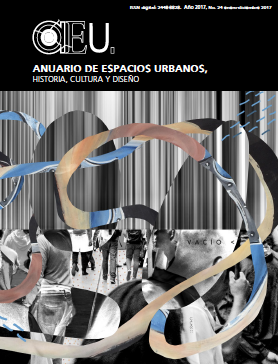The Sound space in the Plaza Santo Domingo
DOI:
https://doi.org/10.24275/LRLA3396Keywords:
soundscape, morphology, perception, Santo Domingo square, utopiaAbstract
This article analyzes the sonorous phenomenon displayed in the urban space through a case study at Plaza Santo Domingo, in Mexico City Downtown, in which the site’s morphology and acoustic perception play key roles in regards to an aesthetic social practice that provides with joy and well-being, but moreover, those two components together enable a possible production of urban spaces around the sonorous phenomenon itself. Enough elements are stated in this text, along with similar studies aiming to develop processes of urban space design that relate acoustic perception as baseline in interaction with urban morphology. Conclusions take part of a research process denominated Sonotopia from which further publications shall demonstrate urban design proposals based from the analysis developed in this article.References
Blesser, B. y Salter, L. R. (2007). Spaces speak, are you listening? Massachusetts: Massachusetts Institute of Technology (MIT).
Carrión, A. (1998). Diseño acústico de espacios arquitectónicos. Barcelona: Edicions UPC.
Guzmán Ríos, V. (2005). “Apropiación, identidad y práctica estética: un sentir juntos el espacio”. En Tamayo, S. y Wildner, K. (Coords.), Identidades urbanas (pp. 229-279). México: Universidad Autónoma Metropolitana.
Hiernaux, D. (2013). “Tensiones socavadas y conflictos abiertos en los centros históricos: Imaginarios en conflicto sobre la Plaza de Santo Domingo, Ciudad de México”. En Ramírez Kuri, P. (Coord.), Las disputas por la ciudad. Espacio social y espacio público en contextos urbanos de Latinoamérica y Europa (pp. 177-198). México: Instituto de Investigaciones Sociales. Instituto de Geografía, Centro de Investigaciones Interdisciplinarias en Ciencias y Humanidades, Programa Universitario de Estudios sobre la Ciudad, Programa de Maestría y Doctorado en Urbanismo, Universidad Bauhaus de Alemania, Universidad Autónoma de Querétaro y Miguel Ángel Porrúa.
Internet:
http://pavimarconstrucciones.com/aislamiento-acustico (visitada el 18 de junio de 2016)
http://acoustics.group.shef.ac.uk/amberquestionnaire.html (visitada el 14 de julio de 2015)
(NOM-081-SEMARNAT-1994) http://www.dof.gob.mx/nota_detalle.php?codigo=5324105&fecha=03/12/2013 (visitada el 4 de julio de 2016).
Kang, J. et al. (2016). “Ten questions on the soundscapes of the built environment, Building and Environment”. Recuperado de: http://dx.doi.org/10.1016/j.buildenv.2016.08.011
Schafer, R. (2013). El paisaje sonoro y la afinación del mundo. Barcelona: Intermedio, Prodimag, S.L.
QUADMAP: LIFE 10 ENV/IT/000407, recuperado de www.quadmap.eu (Quadmap, 2015).
Suárez, E. (2004). Curso de acústica ambiental. Valdivia: Instituto de Acústica, Universidad Austral de Chile.
Urban Environmental Sustainability Survey, Acoustics Group, School of Architecture de la Universidad de Sheffield, recuperado de http://acoustics.group.shef.ac.uk/ amberquestionnaire.html (Sheffield, 2015).
Downloads
Published
How to Cite
Issue
Section
License
Copyright (c) 2017 ANUARIO DE ESPACIOS URBANOS. HISTORIA, CULTURA Y DISEÑO

This work is licensed under a Creative Commons Attribution-NonCommercial-ShareAlike 4.0 International License.










